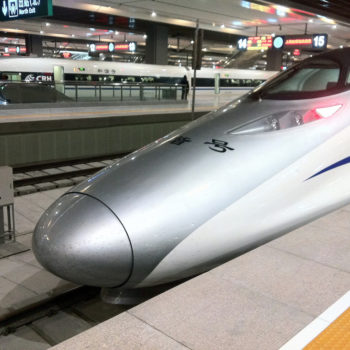In the mid-2000s, Kawasaki, Siemens and other European and Japanese companies began producing high-speed trains in China. They now have competition from domestic companies, such as China South Locomotive & Rolling Stock Corp. (CSR), that manufacture trains with speeds of up to 236 miles per hour.1
By their own admission, the domestic firms learned from the technology and techniques of their foreign counterparts. This kind of technology transfer is the reason many developing countries are encouraged to attract foreign direct investment (FDI) as a means of advancing their own domestic industries.(a)
The theory is that the technology, knowledge, and techniques brought in by experienced foreign investors and managers will spill over to locally-owned firms. FDI and other forms of international investment were thought to play a role, for example, in the rapid economic growth of the Asian Tigers (Singapore, South Korea, Hong Kong, and Taiwan) from the 1960s to the 1990s.(b) In the 1990s, FDI was the biggest source of external financing in developing economies.2 However questions remain about the conventional wisdom regarding FDI: some research suggests that it may provide little net economic benefit and could actually harm domestically-owned plants.3
One such study, by Brian J. Aitken and Ann E. Harrison, examined the impact of FDI in Venezuela, a country that received large amounts of foreign investment over a considerable time-span.4 They analyzed annual data on over 4,000 Venezuelan firms from several industries over the period 1976 to 1989. Foreign equity participation during this time varied significantly across industries; for example, 35% of equity in scientific equipment belonged to foreign sources while foreign interests had zero stake in the petroleum refining industry.(c) Aitken and Harrison’s study improved on previous research by looking at changes over time and distinguishing between industries in its analysis.
The researchers found no evidence to support the claim that FDI causes a net benefit to domestic firms through technology spillover. They found that for small plants (those with less than 50 employees), there is a positive relationship between increased foreign investment and productivity, suggesting that individual plants do benefit from FDI.5 Productivity in domestically owned plants, however, decreases when foreign investment in the rest of a sector increases. A change in the share of foreign equity participation in a sector from 0 to 10% results in up to a 2.67 percentage point drop productivity at domestically-owned plants. The authors attribute this effect to market-stealing by the more productive foreign-backed firms. Overall, while small plants with foreign investment benefit from increased FDI in their own plants, domestically- owned firms’ productivity suffers as foreign ownership increases. If the positive own-plant result and the negative spillover effect are added together, “on balance the impact of foreign investment on domestic plant productivity is quite small,” conclude the authors.
While Aitken and Harrison’s study provides a compelling argument against the commonly held wisdom that foreign direct investment is good for developing countries because of technology spillovers, the degree to which the findings can be generalized to all economies is limited. The study improved on previous research by factoring in foreign investors’ tendency, “to locate in more productive sectors and to invest in more productive plants.”6 It is possible, however, that unique aspects of Venezuela or the 1976-1989 timeframe present results atypical from what is truly the norm.
More than a decade after Aitken and Harrison’s work, there is still disagreement about the impact of FDI on developing economies.7 To attract foreign investment, countries often offer subsidies, tax breaks, favorable tariffs and other inducements. The important question for policymakers in these countries is what benefits developing economies accrue from foreign direct investment and whether they outweigh the costs of attracting such investment. Countries may decide to stack the deck by trying to control and channel the benefits of FDI. China, for example, has required multinational companies doing business in its country to share technology that can then be passed on to domestic firms. While this strategy is not without its risks – foreign companies have not been pleased to see their technology picked up so quickly by Chinese firms – it certainly helps ensure that FDI will enrich domestic industry and not just foreign investors.
Endnotes
- Norihiko Shirouzu (November 17, 2010) “Train Makers Rail Against China’s High-Speed Designs,” Wall Street Journal.
- Brian J. Aitken and Anne E. Harrison (1999) “Do Domestic Firms Benefit from Direct Foreign Investment? Evidence from Venezuela,” The American Economic Review, 89(3): 605-618.
- Holger Görg and David Greenaway (2004) “Much Ado about Nothing? Do Domestic Firms Really Benefit from Foreign Direct Investment?” The World Bank Research Observer, 19(2): 171-197. Gordon H. Hanson (2001) Should Countries Promote Foreign Direct Investment?, G-24 Discussion Paper Series, United Nations.
- Aitken & Harrison (1999).
- For larger plants (those with more than 50 employees), the analysis found no productivity gains once plant-specific differences were accounted for, indicating that foreign entities are selectively investing in the more productive firms.
- Aitken & Harrison (1999).
- For a recent review of the literature see: M. Abdur Rahman Malik, Chaudhry Abdul Rehman, Muhammad Ashraf, Rana Zamin Abbas (2012) “Exploring the Link between Foreign Direct Investment, Multinational Enterprises and Spillover Effects in Developing Economies,” International Journal of Business and Management, 7(1): 230-240.
Sidenotes
- (a) According to the World Bank, foreign direct investment (sometimes written as direct foreign investment or DFI) refers to, “net inflows of investment to acquire a lasting management interest& in an enterprise operating in an economy other than that of the investor.”
- (b) The “Asian Tigers” was a name given to four Asian countries that experienced rapid economic development between the 1960s and 1990s. They were often touted as a model for developing countries as policymakers and economists attempted to identify the secrets to their success.
- (c) Petroleum is a critical part of Venezuela’s economy, accounting for about a third of the country’s GDP and 80% of its export revenue. The oil industry was nationalized by President Carlos Andrés Pérez in 1976 and the state has maintained tight control of it ever since, shutting out foreign influence.
- Norihiko Shirouzu (November 17, 2010) “Train Makers Rail Against China’s High-Speed Designs,” Wall Street Journal.
- Brian J. Aitken and Anne E. Harrison (1999) “Do Domestic Firms Benefit from Direct Foreign Investment? Evidence from Venezuela,” The American Economic Review, 89(3): 605-618.
- Holger Görg and David Greenaway (2004) “Much Ado about Nothing? Do Domestic Firms Really Benefit from Foreign Direct Investment?” The World Bank Research Observer, 19(2): 171-197. Gordon H. Hanson (2001) Should Countries Promote Foreign Direct Investment?, G-24 Discussion Paper Series, United Nations.
- Aitken & Harrison (1999).
- For larger plants (those with more than 50 employees), the analysis found no productivity gains once plant-specific differences were accounted for, indicating that foreign entities are selectively investing in the more productive firms.
- Aitken & Harrison (1999).
- For a recent review of the literature see: M. Abdur Rahman Malik, Chaudhry Abdul Rehman, Muhammad Ashraf, Rana Zamin Abbas (2012) “Exploring the Link between Foreign Direct Investment, Multinational Enterprises and Spillover Effects in Developing Economies,” International Journal of Business and Management, 7(1): 230-240.
- Brian J. Aitken and Anne E. Harrison (1999) “Do Domestic Firms Benefit from Direct Foreign Investment? Evidence from Venezuela,” The American Economic Review, 89(3): 605-618.





